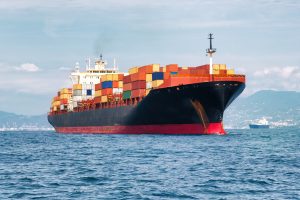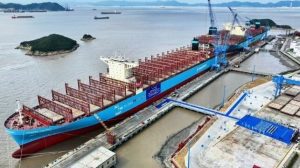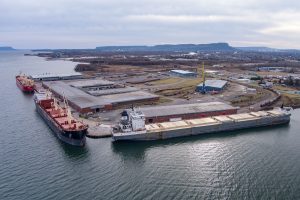With the marine shipping season throughout the Great Lakes and St. Lawrence Seaway commencing tomorrow, it is important to highlight that the industry is the most efficient, cost-effective, and sustainable mode for moving cargo, achieving 558 per cent lower GHG emissions than trucking, and carrying the same amount of cargo in one season as 7.1 million truck trips. It also supports $66.1 Billion in economic activity throughout North America, approximately 360,000 jobs, and moves 252 million tonnes of vital commodities that are key to maintaining quality of life.
In order to fully capitalize on these benefits to achieve stronger supply chains, economic growth, and environmental protection goals, the marine shipping industry needs to see continued partnership from Federal Governments. With this in mind, the Chamber of Marine Commerce (CMC) is announcing its policy and regulatory wish list for 2024, which comprises the following:
- That Canada keeps Pace with U.S. Investment in Marine Infrastructure, and governments prioritize Great Lakes and Seaway shipping:
- In recent years the United States Government has announced unprecedented infrastructure funding for ports and waterways, but the Government of Canada has not invested in the same manner. For example, the U.S. government recently announced $653-million to fund 41 port improvement projects across the U.S. under the Port Infrastructure Development Program – a program dedicated specifically to the enhancement of key marine infrastructure. Meanwhile in Canada, one of the main conduits for investment in marine infrastructure has been the National Trade Corridors Fund, which is actually a general fund for all manner of national projects that has been oversubscribed and currently needs to be replenished. If the disparity in marine infrastructure investment across the border continues, the outcomes could include Canada losing business and experiencing trade disadvantages, having a weaker supply chain, and missing carbon emission reduction targets.
In light of this, the Chamber of Marine Commerce is asking the Government of Canada to, at a minimum, replenish and increase the National Trade Corridor Fund, and redefine Canadian commercial ships as privately held trade-enabling infrastructure to allow access to the Fund. The Chamber is also asking the Government of the United States to ensure that Great Lakes ports are given priority in the coming years when allocating national marine infrastructure funding to ensure this spending has the desired effect from both and economic and environmental enhancement perspective.
Additionally, the Chamber of Marine Commerce asks the Government of Canada to increase the recently established Green Shipping Corridor Fund to encourage more investments in technologies that minimize the environmental footprint of shipping. The fund was established in Budget 2023, but with a Budget of $165.4 million spread over seven years. As ship operators and ports have already invested tens of millions of dollars in initiatives including the use of alternative fuels and electrification, the CMC expects the fund will be oversubscribed quickly, and as such, is asking the government to raise its level of ambition to match our industry.
- That we address government-created hurdles that inhibit trade and competitiveness: At present there are a number of hurdles to trade and supply chain strength that have been created through government actions, but could be corrected quickly with greater collaboration from the Government of Canada. Foremost examples are:
Transport Canada’s Actions Regarding Pilotage:
Recent proposals by Transport Canada regarding pilotage are threatening supply chains and the cost of living throughout Canada. It is important to note that navigation in the waters of the Great Lakes and St. Lawrence River requires licensed or certified pilots to be onboard ships in certain ports and waterways, which in turn makes the availability of professionals who can carry out these duties critical to the movement of goods. Transport Canada is proposing a new national certification and training program that will be much more complex and bureaucratic, costly, and less efficient than the successful pilotage certificate onboard training program already in use in the Great Lakes region – a program with a stellar safety record. This extra red tape will result in fewer certified professionals being available to the marine industry, which in turn could stop ships from moving, and ultimately drive up costs for everyone.
- Canada Border Services Agency Resourcing :
- At present, insufficient staff and other necessary customs-related investments in resources to carry out the agency’s mandate is having the net effect of restricting trade and increasing costs. The Chamber of Marine Commerce requests that the Government of Canada dedicate adequate funds to CBSA for good cargo movement and custom clearance in the Great Lakes.
- That support is provided for marine workforce development:
- 43% of the marine workforce in Canada is expected to retire in the next decade, and it will be necessary to fill an estimated 19,000 jobs onboard Canadian vessels within that timeframe. These realities highlight a concern for supply chain strength, but also an opportunity with respect to the availability of exciting career opportunities for Canadians.
The Chamber of Marine Commerce is asking the Government of Canada for assistance with workforce development initiatives, specifically:
- Recognize seafaring as a skilled trade, allowing seafarers to be eligible for Employment and Social Development Canada funding;
- Provide funding within Transport Canada to establish a Pilotage Training Fund to train and certify captains and recently hired pilots; and
- Address barriers involving Certificates of Proficiency for foreign student internships. At present the Government of Canada will not issue needed Certificates of Proficiency for security training and tanker familiarization training to foreign nationals to enable working at sea. If cadets cannot acquire this certification, they may not complete their mandatory sea time, thus disadvantaging the Canadian institutions training foreign national cadets, and the availability of new talent.
“Throughout the world, we are seeing the rapid adoption of new technologies like AI, research into alternative fuels, and enabling marine-focused legislation and regulation by governments to achieve stronger supply chains and a more sustainable future,” said Bruce R. Burrows, President and CEO, Chamber of Marine Commerce. Businesses and consumers throughout North America could be at the forefront of these developments, but only if we see continued partnership from Federal Governments on the key issues we have highlighted in our Wish List.”
(Photo of Bruce Burrows, CMC President and CEO)








